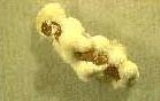
Beauveria
Encyclopedia
Beauveria is a genus
of asexually-reproducing fungi allied with the ascomycete
family Clavicipitaceae
. Its several species are typically insect pathogens
. The sexual states (teleomorphs) of Beauveria species, where known, are species of Cordyceps
.
Beauveria species are white entomopathogenic fungi. They form unicellular conidia that are typically hydrophobic and very small. The conidia are formed holoblastically from basally inflated conidiogenous cells. After conidium production, the conidiogenous cell elongates before producing another conidium atop a small denticle. The result is the formation of a distinctive, slender, zig-zag rachis
. Colonies of Beauveria species are typically white or off-white on artificial culture media.
Species of Tritirachium resemble Beauveria species in having a zig-zag conidiogenous cells, but differ in lacking conspicuous denticles and in producing yellow-brown to purple colonies.
Beauveria species are commonly found associated with insects or habitats supporting insects, including soil and private dwellings. B. bassiana
, the most widely known member of this genus, has been developed as a biological pesticide for various insect pests.
B. simplex is now Acrodontium simplex
; B. nivea is Tolypocladium inflatum
.
Genus
In biology, a genus is a low-level taxonomic rank used in the biological classification of living and fossil organisms, which is an example of definition by genus and differentia...
of asexually-reproducing fungi allied with the ascomycete
Ascomycota
The Ascomycota are a Division/Phylum of the kingdom Fungi, and subkingdom Dikarya. Its members are commonly known as the Sac fungi. They are the largest phylum of Fungi, with over 64,000 species...
family Clavicipitaceae
Clavicipitaceae
Clavicipitaceae is a family of fungi within the order Hypocreales. It consists of 43 genera, and 321 species.-Phylogeny:Molecular phylogenetic analysis of multigene DNA sequence data indicates that the taxon, Clavicipitaceae, is paraphyletic, and consists of three well-defined clades, at least one...
. Its several species are typically insect pathogens
Entomopathogenic fungus
An entomopathogenic fungus is a fungus that can act as a parasite of insects and kills or seriously disables them.-Typical life cycle:These fungi usually attach to the external body surface of insects in the form of microscopic spores...
. The sexual states (teleomorphs) of Beauveria species, where known, are species of Cordyceps
Cordyceps
Cordyceps is a genus of ascomycete fungi that includes about 400 described species. All Cordyceps species are endoparasitoids, mainly on insects and other arthropods ; a few are parasitic on other fungi. The best known species of the genus is Cordyceps sinensis, first recorded as yartsa gunbu in...
.
Beauveria species are white entomopathogenic fungi. They form unicellular conidia that are typically hydrophobic and very small. The conidia are formed holoblastically from basally inflated conidiogenous cells. After conidium production, the conidiogenous cell elongates before producing another conidium atop a small denticle. The result is the formation of a distinctive, slender, zig-zag rachis
Rachis
Rachis is a biological term for a main axis or "shaft".-In zoology:In vertebrates a rachis can refer to the series of articulated vertebrae, which encase the spinal cord. In this case the rachis usually form the supporting axis of the body and is then called the spine or vertebral column...
. Colonies of Beauveria species are typically white or off-white on artificial culture media.
Species of Tritirachium resemble Beauveria species in having a zig-zag conidiogenous cells, but differ in lacking conspicuous denticles and in producing yellow-brown to purple colonies.
Beauveria species are commonly found associated with insects or habitats supporting insects, including soil and private dwellings. B. bassiana
Beauveria bassiana
Beauveria bassiana is a fungus that grows naturally in soils throughout the world and acts as a parasite on various arthropod species, causing white muscardine disease; it thus belongs to the entomopathogenic fungi. It is being used as a biological insecticide to control a number of pests such as...
, the most widely known member of this genus, has been developed as a biological pesticide for various insect pests.
Selected species
- Beauveria bassianaBeauveria bassianaBeauveria bassiana is a fungus that grows naturally in soils throughout the world and acts as a parasite on various arthropod species, causing white muscardine disease; it thus belongs to the entomopathogenic fungi. It is being used as a biological insecticide to control a number of pests such as...
- Beauveria brongniartii
- Beauveria felina
- Beauveria globulifera
B. simplex is now Acrodontium simplex
Acrodontium simplex
Acrodontium simplex is an ascomycete fungus that is a plant pathogen.- External links :* *...
; B. nivea is Tolypocladium inflatum
Tolypocladium inflatum
Tolypocladium inflatum is an asexual ascomycete fungus originally isolated from a Norwegian soil sample that, in certain conditions, produces ciclosporin....
.

